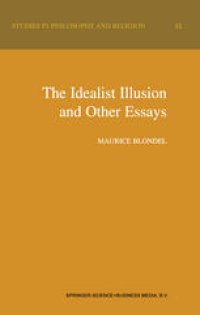
Ebook: The Idealist Illusion and Other Essays: Translation and Introduction by Fiachra Long Annotations by Fiachra Long and Claude Troisfontaines
Author: Maurice Blondel (auth.)
- Tags: Logic, History of Philosophy, Religious Studies
- Series: Studies in Philosophy and Religion 22
- Year: 2000
- Publisher: Springer Netherlands
- Edition: 1
- Language: English
- pdf
I was very happy when in 1997 Fiachra Long came to spend part of his sabbatical leave at the Archives Maurice Blondel at Louvain-Ia-Neuve. This allowed him to bring together and complete his translation of three important articles from Maurice Blondel, known as the philosopher of Aix-en-Province. These three articles fonn a unity: they make explicit certain aspects of the method used in the great thesis of 1893, Action. This thesis, it is well known, aroused many polemic debates after its appearance. Thomist theologians accused Blondel of turning back towards Kantian idealism whereas the philosophers of the Revue de metaphysique et de morale accused him on the contrary of falling back on a pre-critical realism. The three articles translated here, each in its own way, attempt to pass beyond these two opposite charges. The Idealist Illusion (1898) underlines the fact that the content of consciousness should be unfurled as it appears, by withdrawing from any idealist or realist prejudice, before judging the consistency of its content as a whole. In this way Blondel supports the "phenomenological" method used in his thesis. The Elementary Principle of a Logic of the Moral Life (1903) is a very well-worked text which shows that "the logic of possession and privation" is broader than "the logic of amnnation and negation. " Using these words, Blondel develops certain striking laws of action such as that of the "parallelogram of contrary forces.
This book presents three of Blondel's most important articles, which have not yet appeared in English. These are Idealist Illusion (1898), The Elementary Principle of a Logic of the Moral Life (1903), and TheStarting Point of Philosophy (1906). These essays became significant in Blondel's transition from the early Action (1893) to his later works on Thinking (1934), Being and Beings (1935), and Action (1936-7). They offer evidence for and explain the nature of the pragmatism in Blondel's thought, which developed as he began to articulate the logic of action in response to the criticism that he was an idealist. The Introduction argues that Blondel's measured response to this charge led to the development of a metaphysics of the concrete life and allied him closely to the commonsense school of Reid. These articles should interest students of philosophy and theology who want to explore the theme of concrete experience.